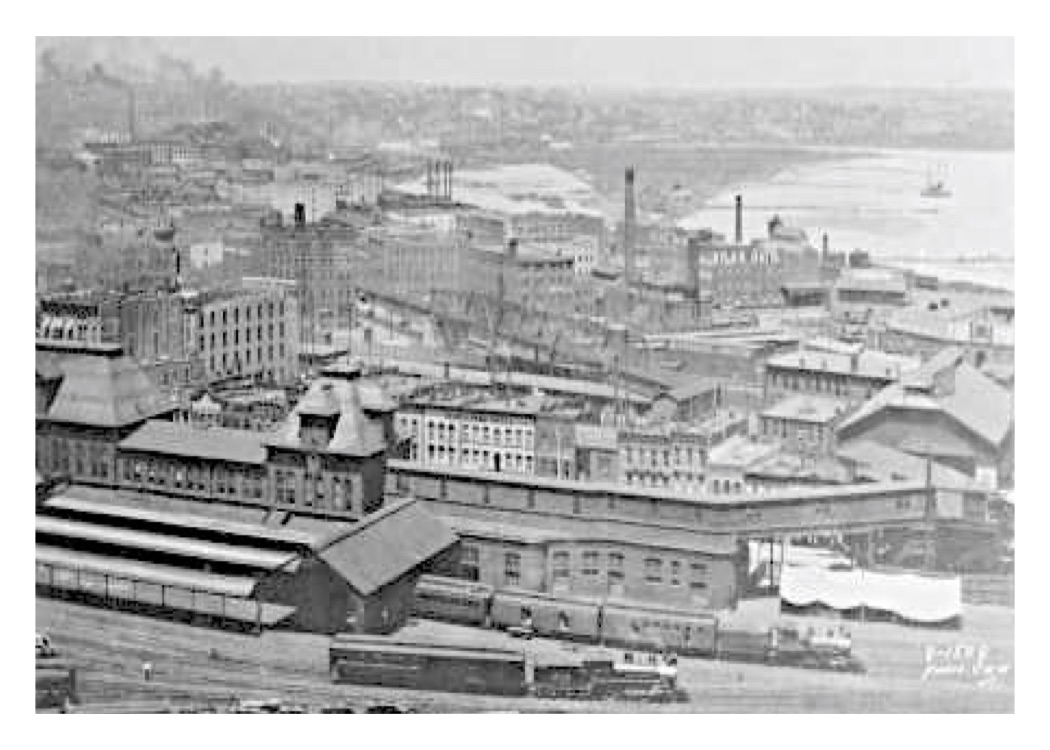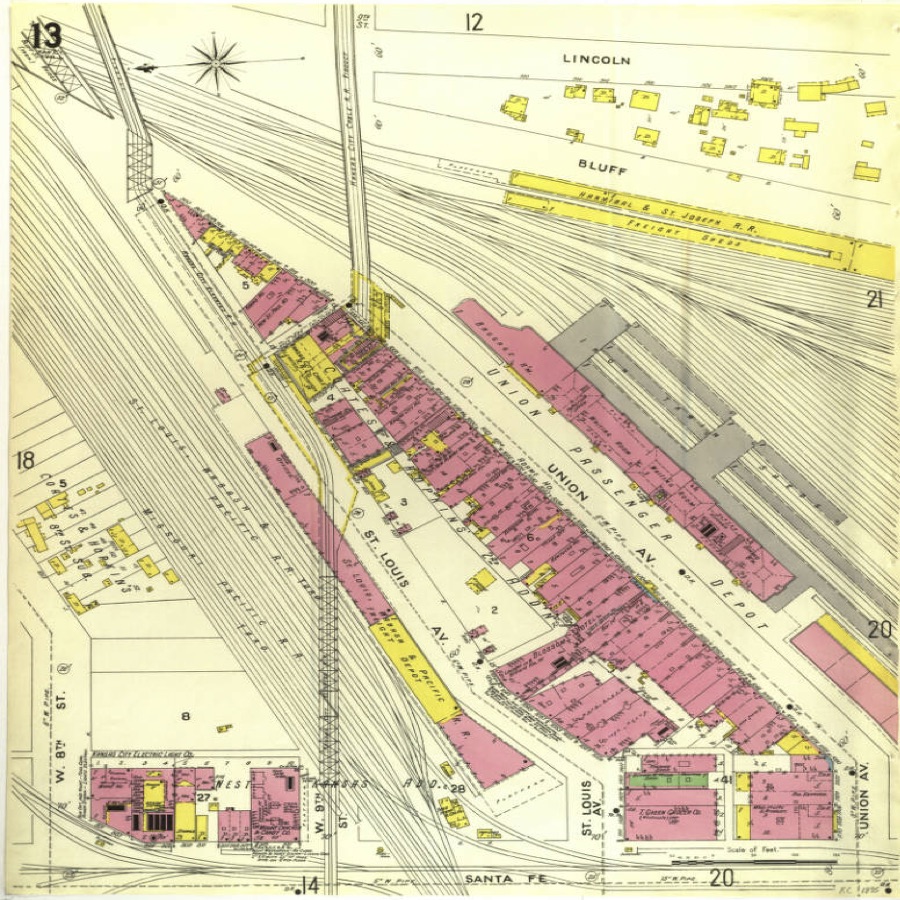Introduction: This is a continuation of a previous blog, “The Dirtiest Place In Town” about the genealogical adventure of Valentine Seeser living in the West Bluffs in Kansas City, Missouri in 1893 when he was summoned to police court over the condition of his house.
After finding the newspaper article, I had no idea the journey it would take me on. As I researched, a story began to unfold connecting the history of a family with the history of my city.
I had connections to the West Bottoms where I worked for ten years completely unaware of the rich history of the area and the community who lived along the bluffs. Now, driving along the interstate that cuts thru the original bluff area, my mind goes back in time and I look at the area differently, as if I have made a personal connection – I have a story to tell.
What made this genealogy journey so much fun was the discovery of a community of people living precariously along a limestone outcrop and exposed to human forces desiring to remove that community, and how a family coped.
Most unexpectedly, I made a connection to a common person who lived in obscurity, but who’s story has become a resource in appreciating our struggles in living. And, her fortitude left a legacy that is represented by living descendants.
This post establishes Valentine’s location in the West Bluffs area and a detailed picture of his community. Placing a person in the historical and cultural perspectives of their time and place is important in genealogical work. As illustrated in Valentine’s example, it helps to see his world and his place in it. Helpful research hints are added!
The West Bluffs in Kansas City
Evidence from the 1893 newspaper article placed Valentine Seeser in a blighted part of the city known as the West Bluffs. This rocky outcrop overlooked the bottom land south of the Missouri River. Known as the West Bottoms, the area was the commercial and industrial center of the city. Rail yards, packing houses, stockyards, factories, and warehouses proliferated the area. [1]

West Bottoms – Kansas City 1895
Missouri Valley Special Collections, Kansas City Public Library, Kansas City, Mo.
The bottoms acted as the transportation life line of the city where passengers arrived in Kansas City via the main railway station, Union Depot. From the depot, arriving passengers could look upwards and see the panorama of the bluffs running between 7th and 17th streets. This was the area where Valentine lived.
The bluffs functioned as a liminal boundary between Quality Hill, an exclusive, wealthy residential neighborhood above and the industrial center stretching below .
Valentine’s Home on the Bluffs
As described in the newspaper article, Valentine’s address on Lincoln Street was located near the Eighth Street electric line power house. Sanborn fire maps show the exact location where Valentine’s home rested, between two electric cable car lines that traversed the bluffs to the bottoms below.

West Bluff & Bottoms Sanborn Fire Map 1895-12 #12
Special Collections, MU Libraries, University of Missouri-Columbia
The 8th Street Tunnel line entered a shaft dug out of the limestone bluff north and underneath where Valentine lived. The 9th Street Incline ran south, a wrought iron structure connecting the city to Union Depot below. A large electrical power house, providing energy to the cable cars, sat just north of 8th street a stones throw away from the residence. [2]
Valentine’s Community
Valentine lived and worked in what was known as the 12th District of Kansas City, Missouri, an area that encompassed the West Bluffs and The West Bottoms. The district represented a fairly heterogeneous population in the 1890s. Whites made up 67% of the area with half of them making up semiskilled and unskilled occupations. One-fifth of the white population consisted of proprietors of various types of businesses and a third were immigrants or the children of immigrants mainly of Irish or German origins.
Blacks represented 33% of the population with many living along Freight, Lincoln, Bluff, and Eighth streets and one of the largest concentrations of black residents in Kansas City. Valentine was incorrectly identified as “colored” in the 1886 directory given the large African American presence of his neighborhood. [3]
Valentine was of German decent, born in Ohio circa 1851, to German immigrants, George Albert Seeser and Theresa Bauer. Valentine grew up in Cincinnati, Ohio where he worked with his father as a produce commission merchant in 1878 under the name George Seeser & Son.
In 1879, Valentine owned a saloon in Cincinnati at 417 Main Street, the produce merchant business only lasting a year. By 1880, George changed careers once again, becoming a cook, an occupation he would retain the rest of his life. [4]

Sanborn Fire Map, Kansas City, Missouri 1895-12, #12
Special Collections, MU Libraries, University of Missouri-Columbia
Valentine made the decision to move further west, arriving in Kansas City by at least 1881. As one of the many semiskilled workers flooding to the Kansas City industrial center in the 12th District area, Valentine found employment as a cook in various places in the West Bottoms. First on the Kansas side, he worked at the Mechanics Hotel on 9th Street in 1883, and in 1889 at the Astor House on Mulberry Street on the Missouri side. [5]
Near the river bank in the bottoms, just north of 9th street and Union Depot, lay a shanty slum area called Hell’s Half Acre which served as an area for unskilled migrants to find cheap housing within walking distance of the rail yards, packing houses, warehouses, and industries where they worked.
The half acre was barely inhabitable, having poor sanitation, lack of clean water, no paving, and infested with saloons, prostitutes, thugs, swindlers, vagabonds and all other sorts of questionable characters. Living on the bluffs was actually a step up, barely. [6]
Certainly Valentine was acquainted with the acre, as he was one who “cuts up the lunch for a saloon at Ninth and Hickory” streets in the bottoms and directories trace his employment in the area as well. [7]
The next blog post, “Living on The West Bluffs of Kansas City,” will describe the living conditions of Valentine as one of the bluff residents and his eventual conflict with a city trying to upgrade its self image.
Genealogy Tip
Maps are essential tools to help place an individual to a location. In this case study, Sanborn Fire Insurance Maps confirmed the written records and illustrate where Valentine lived.
Genealogy Tip
Newspaper articles are fabulous resources for obtaining information of a community and local events.
In this case study, newspaper articles helped to uncover how Valentine’s community was a hotspot of activity and eventually threaten the very existence of Valentine’s family. Candid descriptions of the area provided a colorful and detailed picture of the community.
Genealogy Tip
People lived in communities and getting a picture of a person’s neighborhood or dwelling place can assist in getting a sense of their experience. Take the time to find out.
Endnotes:
1. “Dirtiest Place in Town,” Kansas City Times, 12 March 1893, pg. 2, col. 3.
2. “Wyandotte County and Kansas City, Kansas Historical and Biographical,” Goodspeed Publishers ( The Goodspeed Publishing Company, Chicago: 1890) 440. Theo S. Case, editor, “History of Kansas City, Missouri (D. Mason & Co. Publishers, Syracuse, N.Y. : 1888) 416.
3. Schirmer, Sherry Lamb, A City Divided The Racial Landscape of Kansas City, 1900 – 1960, (University of Missouri Press, Columbia, Missouri : 2002) 33-5.
4. St. John’s Unitarian Church Cincinnati, Ohio, “Record Book I 1839-53, Marriages, 1839-1856,” Frauningen in 1850, # 77, Georg Sieser & Therese Bauer, 31 Aug. 1850; “Church Records and History, 1822-1935,” St. John’s Unitarian Church (Cincinnati, Ohio), “Church Records, 1839-1874,” microfilm publication, FHL microfilm 001,510,039, item 1, digital image, 94/512, Familysearch.com ( https://www.familysearch.org : accessed on 13 Apr. 2018). Valentine is listed in the household of George & Theresa Seeser in 1860 and 1880 (the Seeser family cannot be located in the 1870 census); 1860 U.S. Census, Hamilton County, Ohio, population schedule, Millcreek townhisp, pg. 192, dwelling 1170, family 1299, George Sesser household, digital image, Ancestry.com (https://www.ancestry.com/interactive : accessed on 13 Apr. 2018); citing NARA microfilm publication M653, roll 980; 1880 U.S. Census, Hamilton County, Ohio, population schedule, Cincinnati, 12th Ward, pg. 44 D, dwelling 308, family 403, George Sesser household, digital image, Ancestry.com (https://www.ancestry.com/interactive : accessed on 13 Apr. 2018); citing NARA microfilm publication T9, roll 1026. Williams, compiler, William’s Cincinnati Directory, (Cincinnati Ohio: William & Co.) 1878, pg. 857, 1879, pg. 887, digital images, “U.S. City Directories, 1822 – 1995,”Ancestry.com ( accessed on 13 Apr. 2018). University of Cincinnati Digital Resource Commons, index, death record, Thrasa Sieser, 2 May 1880, Cincinnati, Ohio, digital image, drc.libraries.uc.edu > UC DRC Home > University of Cincinnati Libraries > Historical Records > Cincinnati Birth and Death Records > 1865-1912> Sieser, Thrasa: https://drc.libraries.uc.edu/handle/2374.UC/507237: accessed on 6 May 2018; citing, City of Cincinnati, Cincinnati Health Department, Archives and Rare Books Library, University of Cincinnati. Digital image by Brandon M. Cooper, Famsaga.com on 11 May 2018.
5. Hoye’s, compiler, Hoye’s Kansas City Directory (Hoye City Directory Company, Kansas City., 1881), pg. 118,digital image, “U.S. City Directories, 1822 – 1995,” Ancestry.com ( accessed on 13 Apr. 2018); 1883, pg. 362; 1889, 594.
6. Schirmer, Sherry Lamb, 2002, pg. 33-5.
7. “Dirtiest Place in Town,” 12 March 1893.
